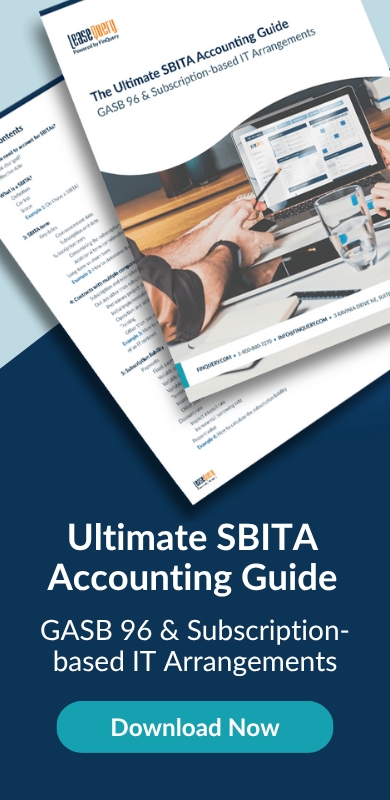The effective date for GASB 87 has passed, but GASB 96 is just around the corner. Many companies working towards compliance with GASB 87 can save time and resources by adopting GASB 96 simultaneously. This article provides a comparison and contrast of both standards, including tips for adopting them at the same time.
GASB 87 overview
GASB 87 is the new lease accounting standard for government organizations. Under the new standard, lease obligations are more accurately portrayed and government financial statements are more useful. The biggest change with GASB 87 is for operating leases. The single model approach requires all contracts considered leases to be classified as finance leases, and to be accounted for similarly to capital leases. The standard is effective for fiscal years starting after June 15, 2021.
GASB 96 overview
GASB 96 establishes accounting guidelines for subscription-based information technology arrangements (SBITAs), including defining what a SBITA is. The goal of this standard is to improve government financial reporting by providing uniform guidance for IT subscriptions which are a growing resource for many state and local government organizations. This standard is effective for fiscal years beginning after June 15, 2022.
Differences between GASB 87 and GASB 96
The accounting rules for GASB 96 are modeled after GASB 87. However, a few differences between the two are apparent. The following are the key differences between GASB 87 and GASB 96.
Terminology
GASB 87 uses terms specific to lease agreements and GASB 96 uses terms specific to SBITAs.
SBITAs can have capitalizable implementation costs
GASB 96 allows certain costs to be capitalized into the subscription asset and amortized over the contract term. While this concept does not exist for leases, it is accounted for in the same way initial direct costs are accounted for under GASB 87.
Balance sheet presentation and footnote disclosures
The information required to be disclosed is consistent with both standards. However, the asset/liability balances are presented in separate line items on the balance sheet and individual footnotes are required for leases and SBITAs.
Similarities between GASB 87 and GASB 96
While the differences between the two require slightly different approaches, they are similar enough to be implemented at the same time. SBITAs are considered very similar to leased tangible assets. Three main similarities between the two standards are explained below.
Liability and asset balances are measured the same way
For both GASB 87 and GASB 96 a liability is calculated from the present value of the remaining required payments and a corresponding asset is derived from the liability. If you use LeaseQuery for your transition to either standard, the lease and SBITA amortization tables have the same mapping to journal entries and reports (although some account labels will change).
Organization and fund structure
The same organization structure, fund allocation, and user roles can apply to both standards.
Subsequent accounting is consistent
Accounting for regular contract activity is the same. The accounting treatment of amendments or contract changes, such as terminations, modifications, impairments, etc., is similar as well.
Tips for adopting GASB 87 and GASB 96
If you implement GASB 96 alongside GASB 87, you can realize efficiencies by only doing certain activities once instead of once for GASB 87 and then again for GASB 96. There are steps you can take now to start the simultaneous adoption process. First, you need to ensure you understand both new standards. Educate yourself on GASB 87 and GASB 96 to familiarize yourself with how they overlap and what the differences are.
Next, determine who needs to be involved with the transition process. Establish an implementation team with people from different departments. It is likely some of the same people are involved in processing both types of contracts. This team can help you gather your lease and your SBITA portfolios at the same time. As the implementation team is reviewing each agreement, have them evaluate which contracts are in scope for GASB 87 and which are in scope for GASB 96 to help establish your lease inventory and SBITA inventory.
When determining whether a software contract will fall under GASB 87 or GASB 96, both standards require that you determine the following three things:
- Who maintains control of the right of use “asset”?
- Is the contract over a set period of time?
- Does the contract include an exchange or exchange-like transaction?
Finally, ensure you have the proper processes and policies in place at your organization to facilitate ongoing compliance. For more information on the adoption process for GASB 96, download The Ultimate GASB 96 Guide.
Summary
Adopting GASB 87 and GASB 96 simultaneously saves your organization time and resources. LeaseQuery’s lease accounting software is compliant with both standards. Use our guide, How To Tackle GASB 87 & 96, alongside LeaseQuery’s software as you transition to the new GASB standards.






